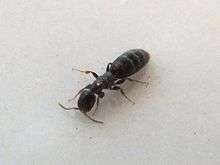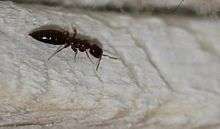Sclerodermus domesticus
| Sclerodermus domesticus | |
|---|---|
 | |
| Scientific classification | |
| Kingdom: | Animalia |
| Phylum: | Arthropoda |
| Class: | Insecta |
| Order: | Hymenoptera |
| Family: | Bethylidae |
| Genus: | Sclerodermus |
| Species: | S. domesticus |
| Binomial name | |
| Sclerodermus domesticus | |
| Synonyms | |
| |
Sclerodermus domesticus, also known as Scleroderma domesticus, Scleroderma domesticum, Scleroderma domestica or "antiquarian's friend", is a species of cuckoo wasp in the Sclerodermus genus of insects. It was first described by Johann Christoph Friedrich Klug in 1809.[1]
Description

Sclerodermus domesticus preys on Coleoptera including Anobium punctatum, Stegobium paniceum, Lasioderma serricorne, Hylotrupes bajulus and Nicobium castaneum, or occasionally Lepidoptera.
Males have wings but lack a stinger. Females are 2–5 mm long; they have a stinger but lack wings. They are black/brown, and have the appearance of ants. Females enter woodworm holes, paralyze the woodworm larvae with the venom of the stinger and lay their eggs in the corpses, which form the food for the S. domesticus larvae. This behavior leads to the common name of "antiquarian's friend".
Distribution and habitat

S. domesticus is a cosmpolitan species. It prefers mild weather. There are reports of the species in Spain, Italy, France, Germany, United Kingdom, former Yugoslavia, Near East, United States and Costa Rica. It can be found inside homes, mostly in old furniture harboring woodworms.
Human infestation is rare. Bites are painful and can cause rash or dermatitis.[2][3][4][5]
References
- Roberto Amerigo Papini (2014), "A case of stings in humans caused by Sclerodermus sp. in Italy", Journal of Venomous Animals and Toxins including Tropical Diseases, 20: 11, doi:10.1186/1678-9199-20-11
- ↑ Sclerodermus domesticus Klug, 1809, BioLib, retrieved 6 June 2018
- ↑ http://www.raco.cat/index.php/SessioEnto/article/download/153651/205550&usg=AOvVaw34hrtFwUIwm-QpD5oN0x_k
- ↑ "Sclerodermus domesticus infestation". www.biomedsearch.com. Retrieved 6 June 2018.
- ↑ Mohar, N.; Dujmović, R.; Uremović, V. (6 June 1985). "Season dermatitis ex insectis caused by stings of Sclerodermus domesticus". Dermatologica. 171 (6): 446–449. PMID 4092800.
- ↑ Jirón, Luis F.; Hanson, Paul; Zeledón, Rodrigo; Jirón, Luis F.; Hanson, Paul; Zeledón, Rodrigo (1 September 2016). "An outbreak of dermatitis produced by the stings of Sclerodermus sp. (Hymenoptera, Bethylidae) in Costa Rica. Central America". Acta Médica Costarricense. 58 (3): 122–125. Retrieved 6 June 2018 – via SciELO.